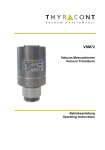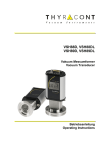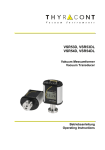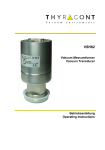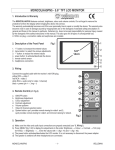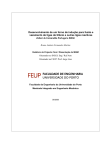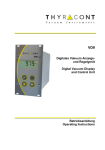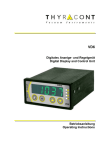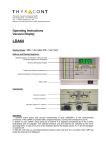Download VSM77D, VSM77DL VSM79D, VSM79DL
Transcript
VSM77D, VSM77DL VSM79D, VSM79DL Vakuum Messumformer Vacuum Transducer Betriebsanleitung Operating Instructions 2 Inhalt 1 2 3 4 5 6 Hinweise für Ihre Sicherheit .......................................................... 3 Vakuum Messumformer VSM ....................................................... 4 2.1 Zur Orientierung ......................................................................... 4 2.2 Lieferumfang............................................................................... 4 2.3 Produktbeschreibung ................................................................. 4 Installation ...................................................................................... 5 3.1 Hinweise zur Installation ............................................................. 5 3.2 Vakuumanschluss ...................................................................... 6 3.3 Elektrischer Anschluss ............................................................... 7 3.3.1 Anschluss an Thyracont Anzeigegeräte ............................. 7 3.3.2 Kundeneigene Spannungsversorgung ................................ 8 Betrieb ............................................................................................. 9 4.1 Allgemeines ................................................................................ 9 4.2 Kommunikation ......................................................................... 10 4.2.1 Die serielle Schnittstelle des VSM .................................... 10 4.2.2 Kommunikationsprotokoll .................................................. 11 4.2.3 Befehlsübersicht ................................................................ 11 4.3 Bedienung des VSM ................................................................. 13 4.4 Nachjustieren ........................................................................... 14 4.5 Gasart-Korrekturfaktoren.......................................................... 17 4.6 Schaltpunkte ............................................................................. 18 4.7 Modus Kaltkathode ................................................................... 19 4.8 Modus Wertangleichung ........................................................... 20 4.9 Ausheizen - Elektronik abnehmen ........................................... 21 Wartung und Service ................................................................... 22 Technische Daten ........................................................................ 24 Konformitätserklärung ......................................................................... 26 Hersteller: Thyracont Vacuum Instruments GmbH Max Emanuel Straße 10 D 94036 Passau Tel.: ++49/851/95986-0 Fax.: ++49/851/95986-40 email: info@thyracont.de Internet: http://www.thyracont.com VSM-de-130903 3 1 Hinweise für Ihre Sicherheit Lesen und befolgen Sie alle Punkte dieser Anleitung Informieren Sie sich über Gefahren, die vom Gerät ausgehen und Gefahren, die von Ihrer Anlage ausgehen Beachten Sie die Sicherheits- und Unfall-Verhütungsvorschriften Prüfen Sie regelmäßig die Einhaltung aller Schutzmaßnahmen Installieren Sie das VSM unter Einhaltung der entsprechenden Umgebungsbedingungen; die Schutzart ist IP40, d.h. die Geräte sind geschützt gegen Eindringen von Fremdkörpern Beachten Sie beim Umgang mit den verwendeten Prozessmedien die einschlägigen Vorschriften und Schutzmaßnahmen Berücksichtigen Sie mögliche Reaktionen zwischen Werkstoffen und Prozessmedien Berücksichtigen Sie mögliche Reaktionen der Prozessmedien infolge der Eigenerwärmung des Produkts Gerät nicht eigenmächtig umbauen oder verändern Informieren Sie sich vor Aufnahme der Arbeiten über eine eventuelle Kontamination Beachten Sie im Umgang mit kontaminierten Teilen die einschlägigen Vorschriften und Schutzmaßnahmen Legen Sie beim Einsenden des Gerätes eine Kontaminationsbescheinigung bei Geben Sie die Sicherheitsvermerke an andere Benutzer weiter Piktogramm-Definitionen Gefahr von Personenschäden Starkes Magnetfeld! Gefahr von Personenschäden Gefahr von Schäden an Gerät oder Anlage Wichtige Information über das Produkt, dessen Handhabung oder den jeweiligen Teil der Betriebsanleitung, auf den besonders aufmerksam gemacht werden soll VSM-de-130903 4 2 Vakuum Messumformer VSM 2.1 Zur Orientierung Diese Betriebsanleitung ist gültig für Produkte mit den Artikelnummern VSM77D, VSM77DL, VSM79D und VSM79DL. Sie finden die Artikelnummern auf dem Typenschild. Technische Änderungen ohne vorherige Anzeige sind vorbehalten. 2.2 Lieferumfang Zum Lieferumfang gehören: Messumformer VSM Staubschutzkappe Betriebsanleitung Lieferbares Zubehör: Messkabel 2m für Anzeigegerät VD9, W1506002 Messkabel 6m für Anzeigegerät VD9, W1506006 Messkabel 2m für Anzeigegerät VD10/VD12, W1515002 Messkabel 6m für Anzeigegerät VD10/VD12, W1515006 Gegenstecker SubD 15polig, XB1500002 2.3 Produktbeschreibung Der Vakuum Messumformer VSM dient zur Absolutdruck-Messung im Bereich -9 1000 - 5x10 mbar. Das Gerät kann an ein Thyracont Anzeigegerät angeschlossen oder gemäß Anschlussbelegung mit einer kundeneigenen Spannungsversorgung betrieben werden. Das analoge Mess-Signal 1,8V - 8,6V ist dabei über den gesamten Messbereich logarithmisch vom Druck abhängig. Zusätzlich besitzt das Gerät eine RS485 Schnittstelle zur digitalen Datenübertragung (siehe Kapitel 4.2). Das Gerät ist mit einem metallgedichteten Kombinationssensor des Typs Pirani / Kaltkathode (invertiertes Magnetron) ausgerüstet und temperaturkompensiert. Es kann an geeignete Flanschverbindungen angeschlossen werden. VSM-de-130903 5 Bestimmungsgemäße Verwendung Das VSM dient ausschließlich der Absolutdruckmessung im Bereich -9 1000 - 5x10 mbar. Es darf nur an geeignete und hierfür vorgesehene Komponenten angeschlossen werden. Nicht bestimmungsgemäße Verwendung Als nicht bestimmungsgemäß gilt der Einsatz zu Zwecken, die von oben genannten abweichen, insbesondere: der Anschluss an Geräte oder Komponenten, die laut ihrer Betriebsanleitung hierfür nicht vorgesehen sind der Anschluss an Geräte, die berührbare, Spannung führende Teile aufweisen. Bei nicht bestimmungsgemäßem Einsatz erlischt jeglicher Haftungs- und Gewährleistungsanspruch Die Verantwortung im Zusammenhang mit den verwendeten Prozessmedien liegt beim Betreiber. 3 3.1 Installation Hinweise zur Installation Starkes Magnetfeld! Das Gerät enthält starke Permanentmagnete. Keine eigenmächtigen Umbauten oder Veränderungen am Gerät vornehmen! Aufstellungsort: Innenräume Für nicht vollklimatisierte Betriebsräume gilt: Temperatur: +5°C ... +60°C Rel. Luftfeuchte: max. 80% bis 30°C, max. 50% bei 40°C, nicht betauend Luftdruck: 860 - 1060 hPa VSM-de-130903 6 3.2 Vakuumanschluss Schmutz und Beschädigungen, insbesondere am Flansch, beeinträchtigen die Funktion dieses Gerätes. Beachten Sie bitte die beim Umgang mit Vakuumkomponenten erforderlichen Regeln in Bezug auf Sauberkeit und Schutz vor Beschädigung. - Staubschutzkappe entfernen (wird bei Instandhaltungsarbeiten wieder benötigt!) - Vakuumanschluss über Kleinflansch DN25 ISO KF (VSM77) oder DN40CFFlansch (VSM79) herstellen - Bei Verbindung über Kleinflansch Metall-Spannelemente verwenden, die sich nur mit einem Werkzeug öffnen und schließen lassen (z.B. SpannbandSpannring), Dichtringe mit Zentrierring verwenden - Sicherstellen, dass der Sensorflansch mit dem Schutzleiter verbunden ist, beispielsweise durch metallischen Kontakt zur geerdeten Vakuumkammer (metallische Spannelemente) Die Einbaulage ist frei wählbar, jedoch kann eine Montage von unten, d.h. mit nach oben gerichtetem Flansch, zu vorzeitiger Verschmutzung und Ausfall des Geräts führen. Zu bevorzugen ist der Einbau von oben, d.h. mit nach unten gerichtetem Flansch, damit sich Staub und Kondensat nicht in der Messzelle ansammeln können. Der Messumformer ist in dieser Lage ab Werk justiert. Bei anderer Einbaulage ist -ohne Nachjustierung- eine erhöhte Messwertabweichung im Druckbereich oberhalb 10 mbar zu erwarten. Das Gerät beim Einbau nicht gewaltsam verdrehen, dies kann zur mechanischen Beschädigung führen! Bei Überdruck im Vakuumsystem > 1 bar Versehentliches Öffnen von Spannelementen kann zu Verletzungen durch herumfliegende Teile führen! Ungesicherte Schlauchverbindungen können sich lösen und Gesundheitsschäden durch ausströmende Prozessmedien herbeiführen! Bei Überdruck im Vakuumsystem 1,5 bis 4 bar Bei KF-Flanschverbindungen können Elastomer-Dichtringe dem Druck nicht mehr standhalten. Dies kann zu Gesundheitsschäden durch ausströmende Prozessmedien führen. VSM-de-130903 7 3.3 3.3.1 Elektrischer Anschluss Anschluss an Thyracont Anzeigegeräte Wird der Messumformer an einem Thyracont Anzeigegerät betrieben, ist ein geeignetes Messkabel zu verwenden (siehe Zubehör). Anschluss des Messumformers niemals mit Spannung führendem Kabel herstellen! Stecker am Messumformer einstecken und mit Schrauben sichern. Gegenüberliegenden Stecker am Anzeigegerät anstecken und sichern. Erst danach Spannungsversorgung am Anzeigegerät herstellen bzw. einschalten. VSM-de-130903 8 3.3.2 Kundeneigene Spannungsversorgung Der Messumformer kann auch mit anderen Anzeigegeräten oder kundeneigener Spannungsversorgung betrieben werden. Die elektrische Verbindung ist unter Verwendung geeigneter Kabel EMV-gerecht gemäß untenstehender Pinbelegung herzustellen: 8 15 1 9 Stecker Typ SubD, 15polig, männlich Pin 1: Pin 2: Pin 3: Pin 4: Pin 5: Pin 6: Pin 7: Pin 8: Pin 9: Pin 10: Pin 11: Pin 12: Pin 13: Pin 14: Pin 15: Identifikation: 33 kΩ Signal Output 0-10 VDC AGND Voltage Supply 24 VDC Supply GND Relay A, N.O. Relay A, Common Relay A, N.C. RS485 + RS485 Shield Relay B, N.O. Relay B, Common Relay B, N.C. Wir empfehlen, Abschirmung (Pin 12) und Speisungserde (Pin5) beim Speisegerät mit Erdung zu verbinden. Falscher Anschluss oder unzulässige Versorgungsspannung können zu Schäden am Messumformer führen. VSM-de-130903 9 4 Betrieb 4.1 Allgemeines Messprinzip Der Vakuum Messumformer VSM besitzt eine interne Kombination aus Piranisensor, der die Wärmeleitfähigkeit von Gasen zur Vakuummessung nutzt, und einem Kaltkathoden-Ionisationssensor (invertiertes Magnetron). Beim Wärmeleitungssensor wird ein Wendel-Filament in einer Wheatstone Brückenschaltung auf eine konstante Temperatur aufgeheizt. Die notwendige Brückenspannung ist ein Maß für den Absolutdruck. Der Kaltkathoden-Sensor erzeugt in einer Gasentladung ionisiert Gasmoleküle. Der gemessene Ionenstrom ist ein Maß für die Anzahl der vorhandenen Gasmoleküle und somit für den Absolutdruck. Ausgangssignal Das Mess-Signal 1,8 - 8,6 V des VSM ist über den gesamten Messbereich von -9 5x10 - 1000 mbar logarithmisch vom Druck abhängig. Die Umrechnung erfolgt gemäß folgendem Zusammenhang: Vout /V = 0,6 log (p/mbar) + 6,8 p /mbar = 10 ( (Vout /V – 6,8) / 0,6 ) Serielle Schnittstelle RS485 Der gemessene Druckwert kann über die serielle RS485 Schnittstelle des Messumformers digital ausgelesen werden. Darüber hinaus können verschiedene Parameter wie Gasart-Korrekturfaktoren programmiert werden. Weitere Informationen hierzu finden sie im Abschnitt 4.2 Kommunikation. Stabilisierungszeit Die Ausgabe des Mess-Signals erfolgt direkt nach Einschalten des Geräts. Zur Ausnutzung der vollen Genauigkeit des VSM kann es -insbesondere nach extremen Drucksprüngen- angebracht sein, eine Stabilisierungszeit von 2min zu beachten. Messgenauigkeit Das Gerät ist ab Werk in stehender Position bei einer Versorgungsspannung von 24VDC abgeglichen. Verschmutzung, Alterung, extreme klimatische Bedingungen oder andere Einbaulagen können ein Nachjustieren erforderlich machen. Im Bereich oberhalb 10mbar ist die Messgenauigkeit reduziert. VSM-de-130903 10 Gasartabhängigkeit Das Mess-Signal ist gasartabhängig. Das Gerät ist auf N2 bzw. trockene Luft abgeglichen. Für andere Gase können via RS485 Korrekturfaktoren für beide Sensortypen gesetzt werden, so dass unterhalb 0,1 mbar eine korrekte Druckausgabe resultiert (siehe Abschnitt 4.2 bzw. 4.5). 4.2 4.2.1 Kommunikation Die serielle Schnittstelle des VSM Der Messumformer VSM verfügt über eine serielle Schnittstelle RS485. Um die Kommunikation über RS485 zu aktivieren, ist zunächst der Gummistopfen über dem Adress-Schalter zu entfernen (1) und anschließend der Adress-Schalter mit einem dünnen Schraubendreher oder ähnlichem Hilfsmittel auf einen Wert zwischen 1 und 16 einzustellen (2). Danach den Gummistopfen wieder einsetzen. Die Kommunikation erfolgt gemäß Thyracont Protokoll, ausführliche Detailinformationen hierzu finden Sie in einer gesonderten Beschreibung. Der analoge Signalausgang 0-10V steht gleichzeitig zur RS485 zur Verfügung! VSM-de-130903 11 4.2.2 Kommunikationsprotokoll Die Kommunikation erfolgt gemäß Thyracont-Protokoll. Die Befehle werden in folgendem Rahmen als Zeichenfolge im ASCII-Code übertragen: Address Code Data cks CR Address: 3 Bytes, dezimal; Adressraum RS485: 001 – 999 Code: 1 Byte, Befehlsparameter, Großbuchstaben für Lesen, Kleinbuchstaben für Schreiben Data: Datenfeld, max. 6 Bytes; kann je nach Code auch fehlen cks: 1 Byte, Checksumme, definiert als Summe über alle Bytes der Felder Addresse, Code und Data, modulo 64 plus 64. CR: Carriage Return (0Dh, 13d) Datenformate: BOOLEAN STRING: UNSIGNED INT: FLOAT: 1 Byte max. 6 Bytes 6 Bytes mit führenden Nullen 6 Bytes, Exponentialformat 4 Bytes Mantisse (entspricht Mantissenwert x 1000) 2 Bytes Exponent, Offset 20 FLOAT-Werte werden in hPa (mbar) übertragen! -4 Beispiel: Der Wert "460016" in einem Float-Datenfeld steht für 4.6x10 mbar. Schnittstellen-Parameter: 9,6 / 14,4 / 19,2 / 38,4 / 57,6 / 115,2 kBd, 8 Datenbits, 1 Stopbit, keine Parität Nach dem Einschalten startet der Transmitter mit 9,6 kBd. Empfängt er Anfrage-Telegramme mit einer anderen Baudrate, so stellt sich der Transmitter automatisch darauf ein. Für diese automatische Baudraten-Erkennung benötigt er maximal zwei Telegramme der Sorte "Typanfrage" oder "Messwertanfrage". 4.2.3 Befehlsübersicht Der Messumformer reagiert auf Typanfragen, Messwertanfragen, Justierbefehle (Abschnitt 4.4) und Befehle zum Setzen von Gasart-Korrekturfaktoren (Abschnitt 4.5). Die Programmierung der beiden Relais-Schaltpunkte des VSM ist ebenfalls via RS485 möglich (Abschnitt 4.6). Darüber hinaus lassen sich Parameter konfigurieren, die das Verhalten der Sensorik bestimmen (Abschnitt 4.7 und 4.8). VSM-de-130903 12 Befehlsübersicht: Befehlstyp Typ Code T Datentyp STRING Messwert Schaltpunkt M S, s FLOAT FLOAT Gasart-Korrekturfaktor C, c UNSIGNED INT Modus Kaltkathode Modus Wertangleichung Druckjustierwert I, i W, w BOOLEAN UNSIGNED INT Funktion lesen (VSM: VSM207) lesen lesen S, schreiben s (VSM: SP1 und SP2) lesen C, schreiben c (VSM: C1 für Pirani, C2 für Kaltkathode) lesen I, schreiben i lesen W, schreiben w j FLOAT schreiben Beispiele (für Adress-Schalterstellung "1"): Aktion Typ lesen Telegramm an Messumformer C "001Te R" Antwort-Telegramm vom Messumformer C "001TVSM207t R" Messwert lesen "001M^ R" Schaltpunkt 2 lesen "001S2V R" Unlock Schaltpunkt 2 "001s2v R" Schaltpunkt 2 auf 4.2x10-4 mbar setzen Unlock Gasart-Korrekturfaktor 1 "001s420016q R" Gasart-Korrekturfaktor 1 auf 1.20 setzen Unlock Justierpunkt für Atmosphärendruck Justieren auf Atmosphärendruck "001c000120W R" C C "001M260014K R" ( 2.6x10-6 mbar) C "001S400016O R" ( 4.0x10-4 mbar) C "001s2v R" C C C C C "001s420016q R" C "001c1e R" "001c1e R" C C C "001c000120W R" C "001j1l R" "001j1l R" C "001j100023a R" C "001j100023a R" Vor dem Schreiben der Parameter "c" (Korrekturfaktor), "s" (Schaltpunkt) und "j" (Justierpunkt) müssen diese zunächst mit einem Unlock-Befehl freigeschaltet werden! VSM-de-130903 13 4.3 Bedienung des VSM Das VSM besitzt eine Status-LED, die folgende Betriebszustände signalisiert: Normalbetrieb / Magnetron on (grün - Dauerleuchten) Normalbetrieb / Magnetron off (grün - langsames Blinken) Fehler ( rot - Dauerleuchten) Bereit zum Nachjustieren (orange - langsames Blinken) Initialisiere Nachjustieren (orange - schnelles Blinken) Die Modelle VSM77DL und VSM79DL verfügen zudem über eine gelb hinterleuchtete LCD Anzeige. Diese zeigt den aktuell gemessenen Ist-Druck. Liegt ein Fehler im Betrieb des Messumformers vor, wird dies durch ein rot hinterleuchtetes Display signalisiert. Zum Ändern der Anzeigeeinheit (mbar, Torr, hPa) während die Spannungsversorgung angeschlossen wird die Adj Taste gedrückt halten bis die Anzeige "Unit" erscheint. Dann die gewünschte Einheit durch Drücken der Adj Taste auswählen. Nach 5 s ohne weiteren Tastendruck wird die Einstellung gespeichert. VSM-de-130903 14 4.4 Nachjustieren Das Gerät ist ab Werk bei Versorgungsspannung 24V stehend, d.h. mit dem Flansch nach unten, abgeglichen. Andere Einbaulagen, Einsatz unter anderen klimatischen Bedingungen, extreme Temperaturschwankungen, Alterung oder Verschmutzung können ein Nachjustieren des Piranisensors erforderlich machen. Nachjustieren am Gerät Ein Nachjustieren auf Atmosphärendruck oder Nulldruck ist digital über den Taster "ADJ" möglich (siehe Bedienschema unten). Der Messumformer erkennt automatisch, um welchen Justierpunkt es sich handelt. -5 Beim Nullabgleich sollte der Ist-Druck kleiner 5,0x10 mbar sein. Um optimale Ergebnisse beim Nachjustieren zu erzielen, empfehlen wir vor jedem Abgleich eine Warmlaufphase von mindestens 5 Minuten beim jeweiligen Kalibrierdruck zu beachten. Zum Justieren den Gummistopfen über dem Taster "ADJ" entfernen (1), dann mit einem dünnen Schraubendreher oder ähnlichem Hilfsmittel kurz auf den Taster drücken (2), bis die Status-LED schnell orange zu blinken beginnt. Nach 3s ohne weiteren Tastendruck signalisiert langsames Blinken, dass der Transmitter nun nachjustiert werden kann. Hierzu nochmals kurz die Taste drücken. Gummistopfen nun wieder einsetzen. VSM-de-130903 15 Status LED grün Normalbetrieb / Magnetron aus Status LED grün Normalbetrieb / Magnetron ein Status LED schnell blinkend Set langsam blinkend Dauerleuchten Status LED orange Initialisiere Nachjustieren Set Status LED grün Normalbetrieb 3s Status LED orange Justieren 10s grün Set Automatische Justierung von Nulldruck oder Atmosphärendruck Pirani 1s grün Status LED grün Normalbetrieb Status LED grün Normalbetrieb 3s Status LED rot Justierfehler Status LED grün Normalbetrieb VSM-de-130903 16 Nachjustieren über RS485 Ein Nachjustieren auf Atmosphärendruck oder Nulldruck ist auch durch entsprechende Software-Befehle über die RS485 Schnittstelle möglich. Um unbeabsichtigtes Justieren des Messumformers zu verhindern, muss der jeweilige Justierpunkt für Atmosphärendruck bzw. Nulldruck zunächst freigeschaltet werden, danach kann die eigentliche Justierung erfolgen. Beispiel für Adress-Schalterstellung "1": Aktion Telegramm an Antwort-Telegramm Messumformer vom Messumformer C C Unlock Justierpunkt für "001j1l R" "001j1l R" Atmosphärendruck C C Justieren auf Atmosphärendruck "001j100023a R" "001j100023a R" C C Unlock Justierpunkt für "001j0k R" "001j0k R" Nulldruck C C Justieren auf Nulldruck "001j000000[ R" "001j000000[ R" Weitere Informationen zum Thyracont-Kommunikationsprotokoll finden Sie in Abschnitt 4.2. VSM-de-130903 17 4.5 Gasart-Korrekturfaktoren Das Mess-Signal des VSM ist gasartabhängig. Das Gerät ist auf N2 bzw. trockene Luft abgeglichen. Für andere Gase kann die Druckausgabe unterhalb 0,1 mbar korrigiert werden, indem Korrekturfaktoren für beide Sensortypen via RS485 gesetzt werden. Die Messwerte der Sensoren werden dann bereits im Gerät jeweils mit den entsprechenden Korrekturfaktoren multipliziert, so dass am analogen und digitalen Ausgang des Messumformers ein korrigiertes Mess-Signal zur Verfügung steht. Korrekturfaktor 1 Pirani: Ar 1,6 CO2 CO 1,0 H2 0,89 0,57 Korrekturfaktor 2 Kaltkathode: Ar 0,80 H2 2,4 CO2 0,74 He 5,9 Address Address: Code: Data: cks: CR: Code He N2 1,0 1,0 Ne Kr 1,4 2,4 N2 Ne 1,0 3,5 Kr Xe 0,6 0,41 Data cks CR 3 Bytes, dezimal; Adressraum RS485: 001 – 999 "C" zum Lesen, "c" zum Schreiben des Korrekturfaktors Leseanfrage oder Unlock: 1 Byte; "1" für Korrekturfaktor Pirani, "2" für Korrekturfaktor Kaltkathode Wert lesen oder schreiben: 6 Byte; unsigned int 1 Byte, Checksumme definiert als Summe über alle Bytes der Felder Address, Code und Data, modulo 64 plus 64. Carriage Return (0Dh, 13d) Der Wert des Datenfeldes beim Lesen oder Schreiben des Korrekturfaktors beinhaltet führende Nullen und entspricht dem 100fachen des Korrekturfaktors. Wertebereich: "000020" für 0.20 bis "000800" für 8.00 Beispiel für Adress-Schalterstellung "1": Aktion Telegramm an Messumformer C Gasart-Korrekturfaktor 2 lesen "001C2F R" Unlock Gasart-Korrekturfaktor 1 C "001c1e R" C Antwort-Telegramm vom Messumformer C "001C000240z R" c2=2.40 C "001c1e R" C Gasart-Korrekturfaktor 1 "001c000057` R" "001c000057` R" auf 0,57 setzen Weitere Informationen zum Thyracont-Kommunikationsprotokoll finden Sie in Abschnitt 4.2. VSM-de-130903 18 4.6 Schaltpunkte Das VSM besitzt 2 unabhängige, potentialfreie Relais-Schaltpunkte. Diese sind als Umschalter gemäß der in Abschnitt 3.3.2 beschriebenen Pinbelegung am Anschluss-Stecker nach außen geführt. Die Schalter sind jeweils bei Druckwerten unterhalb der zugehörigen Sollwerte aktiv und es leuchten die entsprechenden Kontroll-LEDs auf der Steckerseite des VSM. Die Schalthysterese ist fest auf 30% vom Sollwert eingestellt. Die Programmierung der beiden Sollwerte erfolgt via RS485-Schnittstelle. Address Address: Code: Data: cks: CR: Code Data cks CR 3 Bytes, dezimal; Adressraum RS485: 001 – 999 "S" zum Lesen, "s" zum Schreiben des Sollwerts Leseanfrage oder Unlock: 1 Byte; "1" für Schaltpunkt 1 / Relais A, "2" für Schaltpunkt 2 / Relais B Wert lesen oder schreiben: 6 Byte; float 1 Byte, Checksumme definiert als Summe über alle Bytes der Felder Address, Code und Data, modulo 64 plus 64. Carriage Return (0Dh, 13d) Beispiel für Adress-Schalterstellung "1": Aktion Telegramm an Messumformer C Schaltpunkt 2 lesen "001S2V R" Unlock Schaltpunkt 2 C "001s2v R" C Antwort-Telegramm vom Messumformer C "001S400016O R" ( 4.0x10-4 mbar) C "001s2v R" C Schaltpunkt 2 auf "001s420016q R" "001s420016q R" 4.2x10-4 mbar setzen Weitere Informationen zum Thyracont-Kommunikationsprotokoll finden Sie in Abschnitt 4.2. VSM-de-130903 19 4.7 Modus Kaltkathode Bei bestimmten Prozess-Schritten kann es gewünscht sein, das von der Geräteelektronik automatisch gesteuerte Einschalten des Kaltkathodensensors zu unterdrücken. Hierzu ist es möglich, die Kaltkathode per Softwarebefehl über die RS485Schnittstelle zu deaktivieren: "0": "1": Modus "deaktiviert" kein Einschalten der Kaltkathode Modus "aktiv" automatisches Ein- und Abschalten der Kaltkathode Bei deaktivierter Kaltkathode verhält sich der VSM wie ein reiner Pirani-4 Messumformer mit Messbereich 1000 - 1x10 mbar. Entsprechend bedeutet die -4 Ausgabe "ur" in diesem Fall, dass der Druckwert unterhalb 1x10 mbar liegt. Der Parameter "Modus Kaltkathode" wird nur temporär im Gerät gespeichert. Nach Ausfall oder Ausschalten der Spannungsversorgung befindet sich der VSM immer im Modus "Kaltkathode aktiv" ! Address Address: Code: Data: cks: CR: Code Data cks CR 3 Bytes, dezimal; Adressraum RS485: 001 – 999 "I" zum Lesen, "i" zum Schreiben des Parameters 1 Byte; "1" zum aktivieren, "0" zum deaktivieren der Kaltkathode 1 Byte, Checksumme definiert als Summe über alle Bytes der Felder Address, Code und Data, modulo 64 plus 64. Carriage Return (0Dh, 13d) Beispiel für Adress-Schalterstellung "1": Aktion Telegramm an Messumformer C Kaltkathode aktivieren "001i1k R" C Kaltkathode deaktivieren "001i0j R" Modus Kaltkathode lesen "001IZ R" C Antwort-Telegramm vom Messumformer C "001i1k R" C "001i0j R" C "001I1K R" ( aktiv) Weitere Informationen zum Thyracont-Kommunikationsprotokoll finden Sie in Abschnitt 4.2. VSM-de-130903 20 4.8 Modus Wertangleichung Im VSM erfolgt standardmäßig ein kontinuierlicher Übergang zwischen Piraniund Kaltkathodenbereich. Dabei findet eine Wertangleichung statt. Um das Verhalten des Messumformers den Prozessanforderungen optimal anzupassen, können mit dem Parameter "Modus Wertangleichung" per RS485 folgende Optionen konfiguriert werden: 0: keine Wertangleichung, d.h. hartes Umschalten zwischen Pirani und -3 Kaltkathode bei 1.0 x10 mbar -3 Wertangleichung im Bereich 1.0 - 2.0x10 mbar (Standard) 1: Address Address: Code: Data: cks: CR: Code Data cks CR 3 Bytes, dezimal; Adressraum RS485: 001 – 999 "W" zum Lesen, "w" zum Schreiben des Parameters 6 Bytes; "000001" Wertangleichung, "000000" harte Umschaltung 1 Byte, Checksumme definiert als Summe über alle Bytes der Felder Address, Code und Data, modulo 64 plus 64. Carriage Return (0Dh, 13d) Beispiel für Adress-Schalterstellung "1": Aktion Telegramm an Messumformer C Modus Wertangleichung setzen "001w000001i R" auf Wertangleichung C Modus Wertangleichung lesen "001Wh R" Antwort-Telegramm vom Messumformer C "001w000001i R" C "001W000001I R" ( Wertangleichung) Weitere Informationen zum Thyracont-Kommunikationsprotokoll finden Sie in Abschnitt 4.2. VSM-de-130903 21 4.9 Ausheizen - Elektronik abnehmen Soll die Vakuumkammer ausgeheizt werden, so darf die Temperatur am Sensorflansch 80°C nicht überschreiten. Höhere Ausheiztemperaturen bis maximal 160°C am Flansch können realisiert werden, wenn Sie die Elektronikeinheit und den Magneten des Messumformers vor dem Ausheizen des Sensors abnehmen. Hierzu lösen Sie, wie abgebildet, die beiden Madenschrauben und ziehen die Elektronik-Einheit gerade und ohne Drehbewegung nach hinten ab. Die Magnet-Einheit inkl. Dichtring ebenfalls gerade nach hinten abziehen. Messumformer vor dem Abstecken der Elektronik-Einheit von der Versorgungsspannung trennen! Elektroniken und Sensorköpfe nicht untereinander vertauschen! Es darf keinesfalls Feuchtigkeit oder Staub in die ElektronikEinheit gelangen! Beim Montieren auf die Orientierung achten und nicht verdrehen! Dies kann zu Schäden am Gerät führen! Positionierhilfen: Stift auf Unterseite der Magnet-Einheit, Nut am Sensorkopf. Vor dem Anstecken der Elektronik nicht vergessen, die O-RingDichtung wieder oben auf die Magneteinheit zu schieben! VSM-de-130903 22 5 Wartung und Service Vorsicht bei kontaminierten Teilen! Es kann zu Gesundheitsschäden kommen. Informieren Sie sich vor Aufnahme der Arbeiten über eine eventuelle Kontamination. Beachten Sie beim Umgang mit kontaminierten Teilen die einschlägigen Vorschriften und Schutzmaßnahmen. Das Gerät ist wartungsfrei. Äußerliche Verschmutzungen können mit einem feuchten Tuch beseitigt werden. Sollte wider Erwarten ein Schaden an Ihrem VSM auftreten, senden Sie das Gerät bitte mit einer ausgefüllten Kontaminationserklärung (siehe nächste Seite) zur Reparatur an uns. Das Gerät ist nicht zur kundenseitigen Reparatur vorgesehen! Defekte Sensorköpfe können vor Ort ausgetauscht werden (Ersatzteile B_VSM77 bzw. B_VSM79). Fehlfunktionen des Gerätes, die auf Verschmutzung oder Verschleiß zurückzuführen sind, fallen nicht unter die Gewährleistung. Fehlersignal und Störungen Problem Mögliche Ursache Behebung Messwertabweichung zu groß Alterung, Verschmutzung, extreme Temperaturen, falsche Justierung Nachjustieren Messbereich unterschritten (Druck < 5x10-9mbar) Gerät oder Sensor defekt Gerät einschicken Code unbekannt gesendeten TelegrammCode prüfen Bearbeitung des gesendeten Befehls ist momentan nicht möglich Gerät einschicken 0,5V < Mess-Signal < 1,3V/ "000000" via RS485 Mess-Signal <0,5V / "1" via RS485 Status LED dauerrot "5" via RS485 "7" via RS485 logischer Fehler Nachjustieren des PiraniNullpunkts nicht möglich Messwertabweichung übersteigt den Justierbereich VSM-de-130903 23 VSM-de-130903 24 48 153 139 Technische Daten 139 6 69 40 70 Messprinzip Wärmeleitfähigkeit Pirani / Kaltkathode (invertiertes Magnetron) Messbereich 1000 - 5x10-9 mbar (750 - 5x10-9 Torr) Max. Überlast 4 bar abs. Genauigkeit 1000 - 10 mbar: ca. 30 % f.r. (v. Messwert) 10 - 0,002 mbar: 10 % f.r. 0,002 - 10-8 mbar: 25 % f.r. Materialien mit Vakuumkontakt Anodenmaterial Edelstahl 1.4301, Wolfram, Nickel, Glas, Molybdän Anodenspannung < 2,5 kV VSM-de-130903 Molybdän 25 Reaktionszeit 200 ms Betriebstemperatur 5...60 oC Lagertemperatur -40...+65 oC Ausheiztemperatur max. 160°C am Flansch bei abgenommener Elektronik Spannungsversorgung 20 - 30 VDC Leistungsaufnahme max. 3 W, zusätzlich0,8 W für Relais und LCD Ausgangssignal 0 - 10 VDC, min. 10 kΩ Messbereich 1,8 - 8,6 VDC, logarithmisch RS485: 9,6 … 115 kBd, 8 databit, 1 stopbit, no parity Serielle Schnittstelle Schaltausgänge 2x Relais, potentialfrei 50 VAC / 2 A bzw. 30 VDC / 2 A, max. 60 VA Elektrischer Anschluss Sub-D, 15-polig, männl., verschraubbar Vakuumanschluss VSM77: Kleinflansch DN25 ISO KF VSM79: Conflat Flansch DN40 CF Abmessungen 139 x 69 x 48 mm (VSM77) Schutzart IP 40 Gewicht 555 g (VSM77) VSM-de-130903 26 Konformitätserklärung VSM-de-130903 27 Content 1 2 3 4 5 6 Safety Instructions ....................................................................... 28 Vacuum Transducer VSM ............................................................ 29 2.1 For Orientation ......................................................................... 29 2.2 Delivery Content ....................................................................... 29 2.3 Product Description .................................................................. 29 Installation .................................................................................... 30 3.1 Notes for Installation ................................................................ 30 3.2 Vacuum Connection ................................................................. 31 3.3 Electrical Connection ............................................................... 32 3.3.1 Operation With Thyracont Display Unit ............................. 32 3.3.2 Operation With Other Supply And Evaluation Units ......... 33 Operation ...................................................................................... 34 4.1 General ..................................................................................... 34 4.2 Communication ........................................................................ 35 4.2.1 The Serial Interface Of The VSM ...................................... 35 4.2.2 Communication Protocol ................................................... 36 4.2.3 Survey of Commands ....................................................... 36 4.3 Operating the VSM ................................................................... 38 4.4 Readjustment ........................................................................... 39 4.5 Gas-Correction-Factors ............................................................ 42 4.6 Switchpoints ............................................................................. 43 4.7 Mode Cold Cathode ................................................................. 44 4.8 Mode Sensor Transition ........................................................... 45 4.9 Bake-Out – Detachment of Electronics .................................... 46 Maintenance and Service ............................................................ 47 Technical Data .............................................................................. 49 Declaration of Conformity.................................................................... 51 Manufacturer: Thyracont Vacuum Instruments GmbH Max Emanuel Straße 10 D 94036 Passau Tel.: ++49/851/95986-0 Fax.: ++49/851/95986-40 email: info@thyracont.de Internet: http://www.thyracont.com VSM-de-130903 28 1 Safety Instructions Read and follow the instructions of this manual Inform yourself regarding hazards, which can be caused by the product or arise in your system Comply with all safety instructions and regulations for accident prevention Check regularly that all safety requirements are being complied with Take account of the ambient conditions when installing your VSM. The protection class is IP 40, which means the unit is protected against penetration of foreign bodies. Adhere to the applicable regulations and take the necessary precautions for the process media used Consider possible reactions between materials and process media Consider possible reactions of the process media due to the heat generated by the product Do not carry out any unauthorized conversions or modifications on the unit Before you start working, find out whether any of the vacuum components are contaminated Adhere to the relevant regulations and take the necessary precautions when handling contaminated parts When returning the unit to us, please enclose a declaration of contamination Communicate the safety instructions to other users Pictogram-Definition Danger of personal injury! Strong magnetic field! Danger of personal injury. Danger of damage to the unit or system Important information about the product, it's handling or about a particular part of the documentation, which requires special attention VSM-de-130903 29 2 2.1 Vacuum Transducer VSM For Orientation This operating instructions describe installation and operation of products with article numbers VSM77D, VSM77DL, VSM79D and VSM79DL. The article number can be found on the product's type label. Technical modifications are reserved without prior notification. 2.2 Delivery Content Included in the delivery consignment are: Transducer VSM Protective flange cover Operating instructions Available Accessories: Measurement cable 2m for VD9 display unit, W1506002 Measurement cable 6m for VD9 display unit, W1506006 Measurement cable 2m for VD10/VD12 display unit, W1515002 Measurement cable 6m for VD10/VD12 display unit, W1515006 Counterplug 15pole, XB1500002 2.3 Product Description The VSM vacuum transducer is measuring total pressure in the range of -9 1000 - 5x10 mbar. The transducer can be connected to Thyracont display and control units or to customer related power supply and evaluation units in compliance with pin assignment. The analog output signal 1.8V - 8.6V has a logarithmic dependence on pressure over the whole range. In addition the device has a serial RS485 interface for digital data transfer (see chapter 4.2). The transducer is equipped with a metal-sealed combination sensor type Pirani / Cold Cathode (inverted magnetron) and temperature compensated. It can be mounted to suitable flange connectors. VSM-de-130903 30 Proper Use The VSM serves exclusively to provide absolute pressure measurements in the -9 range 1000 - 5x10 mbar. It may only be connected to components specifically provided for such purpose. Improper Use The use for purposes not covered above is regarded as improper, in particular: the connection to components not allowed for in their operating instructions the connection to components containing touchable, voltage carrying parts. No liability or warranty will be accepted for claims arising from improper use. The user bears the responsibility with respect to the used process media. 3 3.1 Installation Notes for Installation Strong magnetic field! The gauge contains strong permanent magnets. Unauthorized modifications or conversions of the instrument are not allowed! Installation location: Indoor For not fully air conditioned open buildings and operation rooms: Temperature: +5°C ... +60°C Rel. Humidity: max. 80% up to 30°C, max. 50% at 40°C, not condensing Air pressure: 860 - 1060 hPa VSM-de-130903 31 3.2 Vacuum Connection Dirt and damage, especially at the vacuum flange, have an adverse effect on the function of this vacuum component. Please take account of the necessary instructions with regard to cleanliness and damage prevention when using vacuum components. - Remove the protective cover (is required again during maintenance work!) - Make vacuum connection via small flange DN25 ISO KF (VSM77) or conflat flange DN40CF (VSM79) - Use clamps, that can be opened and closed with appropriate tools only (e.g. strap retainer-tension-ring), use sealing rings with a centering ring - Make sure that the sensor flange is connected to ground, e.g. by having electrical contact to the grounded vacuum chamber (use metallic clamps) The transducer may be mounted in any orientation. Mounting with the flange to the top, however, can lead to early contamination. An upright orientation with flange to the bottom is to be preferred in order to keep particles and condensates out of the sensor cell. Further the transducer is adjusted in the upright position ex works. Different orientation –without readjustment- will lead to reduced accuracy at pressures above 10 mbar. When mounting the transducer avoid forced twisting or violent opening. This can damage the VSM! Overpressure in the vacuum system > 1 bar Accidental or unintended opening of clamp elements under stress can lead to injuries due to parts flying around! Unsecured hose connections can release, process media thus can leak and possibly damage your health. Overpressure in the vacuum system 1.5 to 4 bar KF flange connections with elastomer sealings cannot withstand such pressures. Process media thus can leak and possibly damage your health. VSM-de-130903 32 3.3 3.3.1 Electrical Connection Operation With Thyracont Display Unit For operation of the transducer with a Thyracont display and control unit a suitable measurement cable must be used (see accessories). Do not connect or disconnect the transducer when the cable is on circuit! Connect the cables plug to the transducer and secure it with the screw. Connect the other end of the cable to the display unit and secure the plug. Only now connect your display unit to mains power or switch it on respectively. VSM-de-130903 33 3.3.2 Operation With Other Supply And Evaluation Units The transducer can be operated with other customer related display units or voltage supplies. The electrical connection is to be made by means of suitable cables considering EMI demands and according to the pin description shown below: 8 15 1 9 Socket Type SubD, 15pole, male Pin 1: Pin 2: Pin 3: Pin 4: Pin 5: Pin 6: Pin 7: Pin 8: Pin 9: Pin 10: Pin 11: Pin 12: Pin 13: Pin 14: Pin 15: Identification: 33 kΩ Signal Output 0-10VDC AGND Voltage Supply 24VDC Supply GND Relay A, N.O. Relay A, Common Relay A, N.C. RS485 + RS485 Shield Relay B, N.O. Relay B, Common Relay B, N.C. We recommend to have Shield (Pin 6) and supply common (Pin5) grounded in the supply unit. Incorrect connection or inadmissible supply voltage can damage the transducer. VSM-de-130903 34 4 Operation 4.1 General Measurement Principle The VSM vacuum transducer is equipped with an internal combination sensor of type Pirani / Cold Cathode. The Pirani principle uses the heat conduction of gases for measuring vacuum. A sensor filament in a Wheatstone circuit is heated to a constant temperature, so the bridge voltage is a measure for total gas pressure. The cold cathode sensor creates ionized gas molecules by an electric discharge. The resulting ion current is a measure for the number of gas molecules present in the sensor and proportional to the absolute pressure. Output Signal The output signal 1.8 - 8.6 V of your VSM has a logarithmic dependence on -9 pressure over the whole measurement range 5x10 - 1000 mbar. Conversion of voltage signal and pressure is done according to the following formula: Vout /V = 0.6 log (p/mbar) + 6.8 p /mbar = 10 ( (Vout /V – 6.8) / 0.6 ) Serial Interface RS485 The measured absolute pressure can be read out digitally via the transducers serial RS485 interface. Additionally you can set various parameters like gas correction factors or setpoints. For further information see chapter 4.2 communication. Warm-Up Time The signal output of VSM is available immediately after the unit is switched on. To take advantage of the maximum accuracy of the unit it is appropriate to allow for stabilization time of 2 minutes, especially when extreme pressure changes have occurred. Accuracy The unit is adjusted ex works in upright position and at 24V voltage supply. Through contamination, ageing, extreme climatic conditions or different mounting orientation the need for readjustment may arise. Accuracy is reduced in the range above 10mbar. VSM-de-130903 35 Dependence On Gas Type The output signal depends on composition and type of the gas being measured. The unit is adjusted for N2 and dry air. For other gases correction factors for both sensor types can be set via RS485 (see chapter 4.2 and 4.5). This results in a correct pressure display below 0.1 mbar. 4.2 4.2.1 Communication The Serial Interface Of The VSM The VSM transducer is equipped with a serial RS485 interface. To enable communication via RS485 please remove the rubber cap over the address switch (1) and then set the address switch to a value between 1 and 15 using a small screw driver or a similar tool (2). Afterwards insert the rubber cap again. Communication is carried out according to the Thyracont protocol, detailed information hereto is provided in a separate description. The analog output signal 0-10V is simultaneously available when RS485 ! VSM-de-130903 36 4.2.2 Communication Protocol Communication is carried out according to the Thyracont protocol. The commands are sent as ASCII-code in the following command frame: Address Code Data cks CR Address: 3 Bytes, decimal; address space RS485: 001 – 999 Code: 1 Byte, command parameter, upper case character for read command, lower case character for write command Data: data field, max. 6 Bytes; can be absent depending on code cks: 1 Byte, checksum, defined as sum over all Bytes of the fields address, code and data, modulo 64 plus 64. CR: Carriage Return (0Dh, 13d) Data Formats: BOOLEAN STRING: UNSIGNED INT: FLOAT: 1 Byte max. 6 Bytes 6 Bytes with leading zeros 6 Bytes, exponential format 4 Bytes mantissa (means mantissa value x 1000) 2 Bytes exponent, offset 20 FLOAT-values are transmitted in hPa (mbar)! -4 Example: Value "460016" in a float type data field means 4.6x10 mbar. Interface-Parameter: 9,6 / 14,4 / 19,2 / 38,4 / 57,6 / 115,2 kBd, 8 data bits, 1 Stopbit, no parity When powered on the transducer starts with 9,6 kBd. If a telegram with different baud rate is received, the transducer will automatically adapt to it. For this automatic baud rate adaption a maximum of two telegrams of type "Type Request" or "Measurement Request" is required. 4.2.3 Survey of Commands The transducer responds to type queries, measurement queries, commands for adjustment (chapter 4.4) and for setting gas correction factors (chapter 4.5). Programming of the two relay switchpoints is also done via RS485 (chapter 4.6). Further special parameters can be configured, which determine the general behaviour of the sensors (chapter 4.7 and 4.8). VSM-de-130903 37 Survey of Commands: Command Type Code T Data Type STRING Measurement Value Setpoint M S, s FLOAT FLOAT Gas-Correction-Factor C, c UNSIGNED INT Mode Cold Cathode Mode Sensor Transition Pressure Adjustment I, i W, w BOOLEAN UNSIGNED INT Function read (VSM: VSM207) read read S, write s (VSM: SP1 and SP2) read C, write c (VSM: C1 for Pirani, C2 for cold cathode) read I, write i read W, write w j FLOAT write Examples (for address-switch in position "1"): Action Read type Telegram to transducer C "001Te R" Answer telegram from transducer C "001TVSM207t R" Read pressure measurement "001M^ R" Read setpoint 2 "001S2V R" Unlock setpoint 2 "001s2v R" Set setpoint 2 to 4.2x10-4 mbar Unlock gas-correction-factor 1 "001s420016q R" Set gas-correction-factor 1 to 1.20 Unlock adjustment for atmosphere pressure Adjust on atmosphere pressure "001c000120W R" C C "001M260014K R" ( 2.6x10-6 mbar) C "001S400016O R" ( 4.0x10-4 mbar) C "001s2v R" C C C C C "001s420016q R" C "001c1e R" "001c1e R" C C C "001c000120W R" C "001j1l R" "001j1l R" C "001j100023a R" C "001j100023a R" Before writing the parameters "c" (correction factor), "s" (setpoint) and "j" (adjustment) you must activate them by sending the corresponding unlock command! VSM-de-130903 38 4.3 Operating the VSM The VSM is equipped with a status LED which signalizes the following operational states: Normal Operation / Magnetron on (green LED continuously on) Normal Operation / Magnetron off (green LED flashing slowly) Error (red LED continuously on) Ready for Adjustment (orange LED flashing slowly) Initializing Adjustment (orange LED flashing quickly) In addition models VSM77DL and VSM79DL have an LCD with yellow backlight, that displays the measured actual pressure. In case of an operation error or malfunction the display is illuminated by a red background color. In order to change the display unit (mbar, Torr, hPa) hold the Adj key pressed while connecting power supply until the display shows "Unit". Then select the desired unit by pressing the Adj key. After 5 seconds without further keypress the setting is saved. VSM-de-130903 39 4.4 Readjustment The transducer is adjusted ex works with 24V voltage supply in upright position, flange to the bottom. Other orientation, operation under different climatic conditions, extreme temperature changes, ageing or contamination can result in the need for readjustment of the Pirani sensor. Readjustment by pushbutton Readjustment on atmosphere or zero pressure can be done by means of the ADJ pushbutton of the VSM (see operating scheme below). The transducer will notice automatically which adjustment point is relevant. For zero adjustment actual pressure should be less than -5 5,0x10 mbar. To achieve optimum results of the adjustment we recommend to consider a warm-up of at least 5 minutes at the appropriate calibration pressure before any adjustment. For adjustment first remove the rubber cap above the ADJ button (1), then press the pushbutton several times by means of a screwdriver or other suitable tool (2) until the status LED starts quickly flashing orange. After further 3s a slowly flashing status LED signalizes that the transducer now can be readjusted by pushing the button once again. Finally insert the rubber cap again. VSM-de-130903 40 Status LED green Normal Operation / Magnetron off Status LED green Normal Operation / Magnetron on Status LED flashing quickly Set flashing slowly continuously on Status LED orange Initializing Adjustment Set Status LED green Normal Operation 3s Status LED orange Adjustment 10s orange Set Automatic Adjustment of zero or atmosphere pressure Pirani 1s green Status LED green Normal Operation VSM-de-130903 Status LED green Normal Operation Status LED red 3s Adjustment Error Status LED green Normal Operation 41 Readjustment via RS485 Readjustment on atmosphere or zero pressure is also possible by means of software commands via RS485 interface. To avoid unintended adjustment the corresponding adjustment point for atmosphere or zero pressure must be unlocked before the actual adjustment can be performed. Example (for address-switch in position "1"): Action Telegram to Answer telegram transducer from transducer C C Unlock adjustment point for "001j1l R" "001j1l R" atmosphere pressure C C Adjustment on atmosphere "001j100023a R" "001j100023a R" C C Unlock adjustment point for "001j0k R" "001j0k R" zero pressure C C Adjustment on zero "001j000000[ R" "001j000000[ R" Please find further information about the Thyracont communication protocol in chapter 4.2. VSM-de-130903 42 4.5 Gas-Correction-Factors The output signal of the VSM depends on type and composition of the gas being measured. The unit is adjusted for N2 and dry air. For other gases the pressure display can be corrected below 0.1 mbar by setting correction factors for both sensor types via RS485. The measurement results of both sensors are then individually multiplied with the corresponding correction factors by the units microcontroller. The VSM can thereby provide a corrected pressure signal as analog and digital output. Correction factor 1 Pirani: Ar 1,6 CO2 CO 1,0 H2 0,89 0,57 Correction factor 2 Cold Cathode: Ar 0,80 H2 2,4 CO2 0,74 He 5,9 Address Address: Code: Data: cks: CR: Code He N2 1,0 1,0 Ne Kr 1,4 2,4 N2 Ne 1,0 3,5 Kr Xe 0,6 0,41 Data cks CR 3 Bytes, decimal; address space RS485: 001 – 999 "C" for reading, "c" for writing a correction factor Query to read or unlock: 1 Byte; "1" for correction factor Pirani, "2" for correction factor cold cathode read or write: 6 Byte; unsigned int 1 Byte, checksum, defined as sum over all Bytes of the fields address, code and data, modulo 64 plus 64. Carriage Return (0Dh, 13d) The value in the data field when reading or writing correction factors contains leading zeros and is equal to the 100fold of the factor. Range: "000020" for 0.20 to "000800" for 8.00 Example (for address-switch in position "1"): Action Telegram to transducer C Read gas correction factor 2 "001C2F R" Unlock gas correction factor 1 Answer telegram from transducer C "001C000240z R" c2=2.40 C "001c1e R" C "001c1e R" C C Set gas correction factor 1 "001c000057` R" "001c000057` R" to 0.57 Please find further information about the Thyracont communication protocol in chapter 4.2. VSM-de-130903 43 4.6 Switchpoints The VSM provides 2 independent, potential-free relay switchpoints. These are available as change-over switches at the connector according to the pin assignmentals described in chapter 3.3.2. The switches are active below the corresponding pressure setpoints. The control LEDs at the connector side of the VSM are on then. The hysteresis is fixed to 30% from the setpoint value. The programming of both setpoints is done via RS485 interface. Address Address: Code: Data: cks: CR: Code Data cks CR 3 Bytes, decimal; address space RS485: 001 – 999 "S" for reading, "s" for writing setpoints Query to read or unlock: 1 Byte; "1" for setpoint 1 / relay A, "2" for setpoint 2 / relay B Read or write setpoint: 6 Byte; float 1 Byte, checksum, defined as sum over all Bytes of the fields address, code and data, modulo 64 plus 64. Carriage Return (0Dh, 13d) Example (for address-switch in position "1"): Action Telegram to transducer C Read setpoint 2 "001S2V R" Unlock setpoint 2 Answer telegram from transducer C "001S400016O R" ( 4.0x10-4 mbar) C "001s2v R" C "001s2v R" C C Set setpoint 2 to "001s420016q R" "001s420016q R" 4.2x10-4 mbar Please find further information about the Thyracont communication protocol in chapter 4.2. VSM-de-130903 44 4.7 Mode Cold Cathode For certain vacuum processes it may be favoured to suppress the start of the cold cathode sensor, which is automatically controlled by the transducer electronics. Therefore it is possible to disable the cold cathode by software command via RS485 interface: "0": "1": Mode " disabled " cold cathode sensor remains switched-off Modus " enabled " start of cold cathode is automatically controlled by the transducer (standard) When the cold cathode is disabled your VSM behaves like a Pirani transducer -4 with range 1000 – 1x10 mbar. Correspondingly the output "ur" in this case -4 means that actual pressure is below 1x10 mbar. Parameter "Mode Cold Cathode" is only temporarily saved in the transducer memory. After mains supply is switched off or disconnected the VSM will always be in mode "cold cathode enabled" ! Address Address: Code: Data: cks: CR: Code Data cks CR 3 Bytes, decimal; address space RS485: 001 – 999 "I" for reading, "i" for writing the parameter 1 Byte; "1" to enable, "0" to disable the cold cathode sensor 1 Byte, checksum, defined as sum over all Bytes of the fields address, code and data, modulo 64 plus 64. Carriage Return (0Dh, 13d) Example (for address-switch in position "1"): Action Telegram to transducer C Enable cold cathode "001i1k R" C Disable cold cathode "001i0j R" Read mode cold cathode "001IZ R" C Answer telegram from transducer C "001i1k R" C "001i0j R" C "001I1K R" ( enabled) Please find further information about the Thyracont communication protocol in chapter 4.2. VSM-de-130903 45 4.8 Mode Sensor Transition By default the VSM performs a continuous transition between Pirani and cold cathode range whereupon an assimilation of the sensor signals is carried out. In order to adapt the performance of the transducer to the requirements of the vacuum process you can configure the parameter "mode sensor transition" according to the following: 0: no transition, but direct switch-over between Pirani and cold cathode at -3 1.0 x10 mbar -3 continuous transition in the range 1.0 – 2.0x10 mbar (standard) 1: Address Address: Code: Data: cks: CR: Code Data cks CR 3 Bytes, decimal; address space RS485: 001 – 999 "W" for reading, "w" for writing the parameter 6 Bytes; "000001" transition, "000000" direct switch-over 1 Byte, checksum, defined as sum over all Bytes of the fields address, code and data, modulo 64 plus 64. Carriage Return (0Dh, 13d) Example (for address-switch in position "1"): Action Telegram to transducer C Set mode sensor transition "001w000001i R" to continuous transition C Read mode sensor transition "001Wh R" Answer telegram from transducer C "001w000001i R" C "001W000001I R" ( transition) Please find further information about the Thyracont communication protocol in chapter 4.2. VSM-de-130903 46 4.9 Bake-Out – Detachment of Electronics When a bake-out of the vacuum chamber is performed the temperature at the sensor flange must not exceed 80°C. Higher bake-out temperatures up to 160°C at the sensor flange can be realized if the electronics unit and the magnets of the transducer are detached. For this purpose unlock the two grub screws as shown below and pull the electronics unit straight and without twisting off the flange. Then pull off the magnets, too. The transducer must be disconnected from voltage supply before detaching the electronics unit! Do not interchange electronics units and sensor heads! Make sure that no moisture or dust can intrude the electronics unit! During reassembly pay attention to correct orientation, do not twist while attaching! This can damage the transducer! Means for positioning: bolt on the bottom plate of the magnet housing, notch at the sensor head. VSM-de-130903 47 5 Maintenance and Service Danger of possibly contaminated parts! Contaminated parts can cause personal injuries. Inform yourself regarding possible contamination before you start working. Be sure to follow the relevant instructions and take care of necessary protective measures. The unit requires no maintenance. External dirt and soiling can be removed by a damp cloth. Should a defect or damage occur on your VSM, please send the instrument to us for repair and enclose a decontamination declaration. The unit is not prepared for customer repair! Defective sensor heads can be exchanged on-site (spare parts B_VSM77 or B_VSM79). Malfunction of the unit, which is caused by contamination or wear and tear is not covered by warranty. Error messages and malfunction Problem Possible Cause Correction high measurement error contamination, ageing, extreme temperature, maladjustment readjustment 0.5V < output signal < 1.3V / pressure under range "000000" via RS485 output signal < 0.5V / defective unit or sensor "1" via RS485 Status LED continuously red "5" via RS485 Code unknown (pressure < 1x10-9mbar) "7" via RS485 command cannot be executed at the moment send unit for repair logic error zero adjustment not possible measurement error exceeds possible range of readjustment send unit for repair check sent telegram code VSM-de-130903 48 VSM-de-130903 49 48 153 139 Technical Data 139 6 69 40 70 Measurement Principle Heat conduction Pirani / Cold Cathode (inverted magnetron) Measuring Range 1000 - 5x10-9 mbar (750 - 5x10-9 Torr) Max. Overload 4 bar abs. Accuracy 1000 - 10mbar: ca. 30 % f.r. (from reading) 10 - 0,002mbar: 10 % f.r. 0,002 – 10-8 mbar: 25 % f.r. Materials with vacuum contact stainl. steel 1.4301, tungsten, nickel, glass, molybdenium Anode Material molybdenium Anode Voltage < 2,5 kV VSM-de-130903 50 Reaction Time 200 ms Operating Temperature 5...60°C Storage Temperature -40...+65 °C Bake Out temperature max. 160°C at the flange when electronics is detached Voltage Supply 20 - 30 VDC Power Consumption max. 3 W, additionally 0.8 W for relays and LCD Output Signal 0 - 10 VDC, min. 10 kΩ measuring range 1,8 - 8,6 VDC, logarithmic Serial Interface RS485: 9.6 … 115 kBd, 8 databit, 1 stopbit, no parity Switchpoints 2x relay, potential free 50 VAC / 2 A or 30 VDC / 2 A, max. 60 VA Electrical Connection Sub-D, 15-pole, male., lockable Vacuum Connection VSM77: small flange DN25 ISO KF VSM79: conflat flange DN40 CF Dimensions 139 x 69 x 48 mm (VSM77) Protection Class IP 40 Weight 555 g (VSM77) VSM-de-130903 51 Declaration of Conformity VSM-de-130903 VSM-de-130903




















































